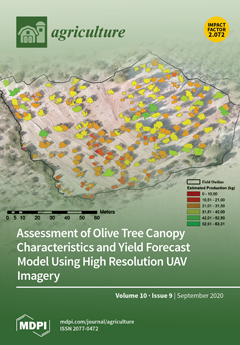Site-specific forage management (SSFM), comprising growth observation, impact assessment, and timely strategic response to small variations in sericea lespedeza (SL;
Lespedeza cuneata (Dum-Cours.) G. Don) production, has been envisioned as a life-changing approach for resource-poor (R-P) farmers in developing countries, assisting in the
[...] Read more.
Site-specific forage management (SSFM), comprising growth observation, impact assessment, and timely strategic response to small variations in sericea lespedeza (SL;
Lespedeza cuneata (Dum-Cours.) G. Don) production, has been envisioned as a life-changing approach for resource-poor (R-P) farmers in developing countries, assisting in the effective rearing of their small ruminants. The application of geospatial technologies, including geographic information systems (GIS), remote sensing, global navigation satellite system, and information technology, can support SSFM but has not been widely used for site-specific forage management. From our previous studies, it appears that the entire range of condensed tannins of lespedeza, namely extractable condensed tannin (ECT), fiber-bound condensed tannin (FBCT), and protein-bound condensed tannin (PBCT), as well as crude protein (CP), are excellent for promoting small ruminant digestion and overall health. The goal of this study was to develop an SSFM strategy for SL to enhance animal production in areas of drought-prone, low pH, marginally infertile soils. To achieve this goal, study objectives were to: (i) develop statistical and artificial neural networks-based (ANN) models to identify if a sound correlation exists among forage growth environmental features and SL-ECT content; (ii) determine suitability criteria, including climate, soil, and land use/land cover (LULC), for mass scale production of SL and collect supporting environmental geospatial data; and (iii) develop an automated geospatial model for SL growth suitability analysis in relation to optimal areas for its production in a case-study location. Telemetric data and individual climatologic parameters (including minimum, maximum, and average temperature, humidity, dewpoint, soil temperatures at three depths, soil moisture, evapotranspiration, total solar radiation, and precipitation) were found to correlate well (>75%) with the forage production parameters, including values of SL-ECT from the Fort Valley State University (FVSU) research station in Georgia in the southern United States. A backpropagation neural network (BPNN) model was developed using similar climatic input parameters, along with elevation (topography) and a normalized difference vegetation index (NDVI) to estimate the forage’s ECT with a testing root mean square error (RMSE) of 1.18%. With good correlation obtained between the climatic, soil, slope, and land cover input parameters, and SL-ECT as the output parameter, an SSFM model was developed with potential application to R-P farmers in areas suitable for SL establishment and growth. Eswatini (previously Swaziland), a landlocked country in southern Africa, in which numerous R-P small ruminant (sheep and goat) farmers reside, was used as the case study location to develop the SL production suitability model. Geospatial data were used for automated model development in an ArcGIS Pro ModelBuilder platform to provide information on where to grow SL efficiently to economically feed small ruminants. Land use/land cover, soil, topography, and climate based geospatial data of the region helped in the development of the automated SSFM geospatial model for spatial growth suitability location determination to assist farmers of Eswatini with their SL production decision making. This automated model can easily be replicated for farmers in other countries in Africa, as well as in other parts of the world having similar climatic conditions.
Full article





